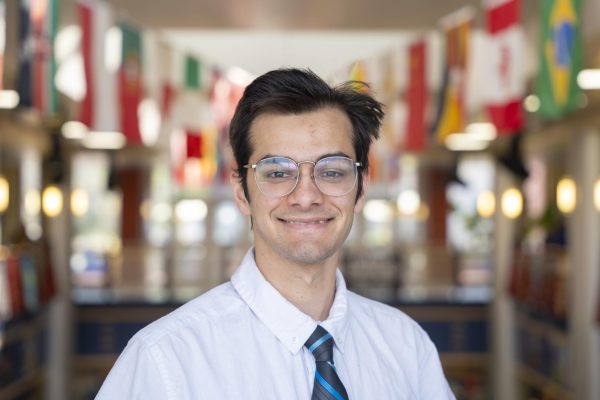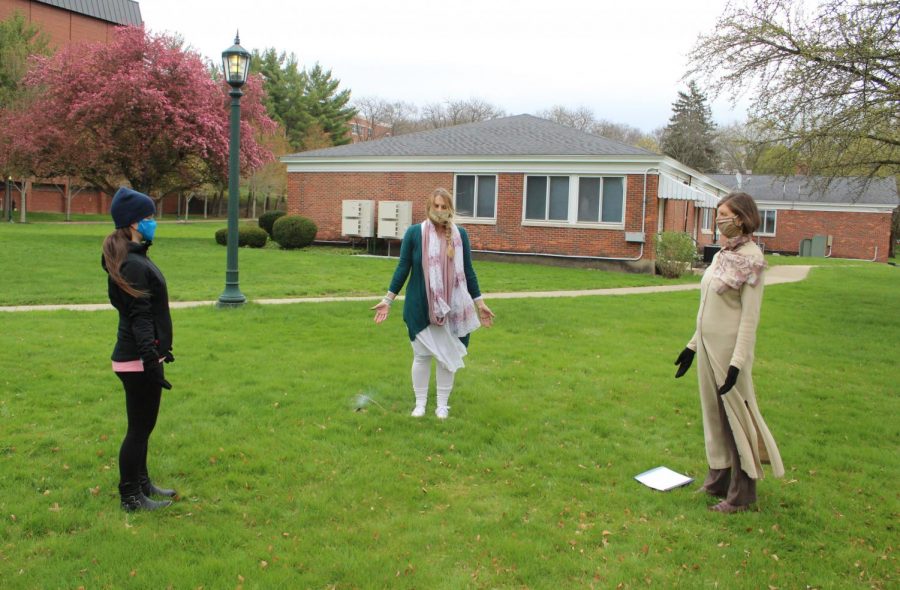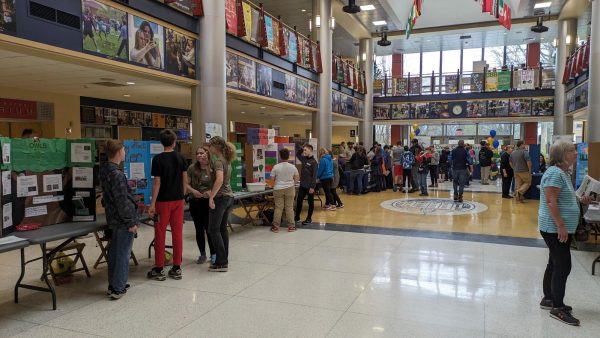SRL hosts event for healing, grieving after hard year
From left: Stephanie Bramwell, ’21, Gretchen Wood, and Jane Ellen Nickell meditate at the southeast corner of Murray Lawn
On Tuesday evening in the southeast corner of Murray Lawn, the Spiritual and Religious Life Office hosted an event for healing and acknowledging losses over the last year.
The event, titled “Healing Service: For the Earth and Ourselves,” was non-denominational, but incorporated elements of Native American, Celtic and other indigenous spiritual traditions. The service itself was conducted by Jane Ellen Nickell, the campus chaplain, and Gretchen Wood, Meadville-based trauma-informed yoga instructor who also offers weekly yoga sessions for Allegheny students.
Nickell noted that the service was not designed to follow one specific tradition, but was intended to be as open and inclusive as possible.
“It (was not) specifically religious,” Nickell said. “We’re not praying, we’re not invoking God. People who are religious are welcome, and add their own prayers within their own experience, but for people who are not religious, we’re hoping we designed something welcoming and healing for them.”
The service opened with a sage blessing, to cleanse the auras of those involved and clear any pre-existing energy that was already attached to participants. Black sage was also burned at the corners of the space as an added cleanser. According to Wood, the use of sage in this manner was primarily used by Native Americans, though it has a myriad of uses in other indigenous traditions.
Nickell acknowledged the gingko trees that stand in that corner of Murray Lawn, noting that they have long been used for ingredients in traditional medicines, calling them a “link to the ancient past.” She also named the original peoples indigenous to the Meadville area, including the Erie and Lenni Lenape peoples.
The first ritual proper was the Ritual of Four Directions, where participants turn to each of the cardinal directions and acknowledge the energies and associations made with each direction. Nickell noted that many traditional spiritualities incorporate a type of the ritual, and so named the most common associations. For example, the East, she said, is associated with the morning sun, the element of air and new beginnings. The West is associated with night, the element of earth, and winter. In addition to the four standard compass directions, Nickell added that Celtic traditions include three more directions: above, below and within.
Once the directions were named, Wood led the group in a meditation. She spoke of grounding oneself in the earth and connecting the earth and sky through oneself with “a golden thread of energy.” This meditation was, like the sage blessing, intended to set participants in a mindset to acknowledge and heal from losses.
After the meditation, Nickell opened the space for “a time of naming losses;” participants were invited to name any losses that they had experienced over the past year, be they personal or communal. The group would then reply with, “May they be healed.” The list was wide and varied: Stephanie Bramwell, ’21, noted the loss of the first-year experience for many students, while Nickell recalled Bill Watts, a former general manager at Parkhurst Dining until he died of complications from COVID-19 over the summer. Wood named a personal loss of security and feeling safe. Racial and social trauma from police killings, the death toll from COVID-19 and ecological losses from climate change were also named.
After naming the losses, the group moved into healing from the losses. Wood led participants in a “reiki” or universal energy healing session. Also known as palm healing, the technique revolves around using one’s palms to direct the energy of the world around them to heal others and themselves. This session was similar to the opening meditation, but rather than focusing on grounding themselves, Wood instructed participants to reach into the core of the Earth as the place where Gaia, or Mother Earth, energy primarily resides and connect it to the air and sky energy.
To close, Nickell read the “Prayer of Healing” from the United Nations Environmental Sabbath Service, a non-denominational prayer service that celebrates the environment as a part of the service. The prayer, which includes an audience response of, “We join with the Earth, and with each other,” spoke of communing with the Earth in a similar way to the reiki healing. It also spoke to the named losses associated with climate change, a focus that Nickell said was a driver to hold the service in the first place.
“(The event) comes out of a couple different impulses,” Nickell said. “One is this college’s devotion to environmental issues; we’ve done Earth Day services in the past that were religious in nature.”
After the event was over, Bramwell thanked Nickell and Wood for the event, calling the service, “a really lovely way of preparing for Earth Day.”
Bramwell was the only students who attended.. Nickell said that a large part of the low turnout was due to the chilly, windy weather.
“When we envisioned this, we saw a bright sunny day, and everyone was able to take their shoes off and connect to the ground,” Nickell said.
Before beginning the service and rituals themselves, Wood acknowledged the intent of the event: to bless the campus space and to help heal anyone who may have been affected by personal or communal loss, regardless of the attendance.
“It’s very honorable to come to a place with the intention to heal,” Wood said.

Sami Mirza is a senior from many different places. He is majoring in International Studies with a focus on the Middle East and North Africa and minor in...












